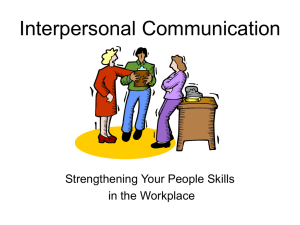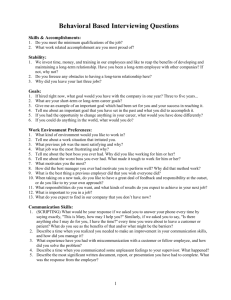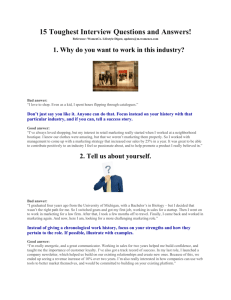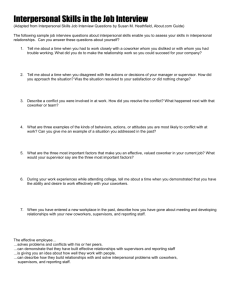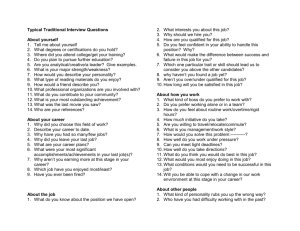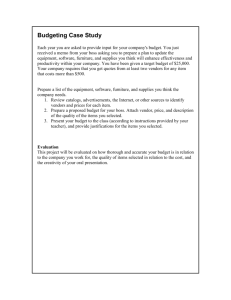Dealing With Difficult People
advertisement
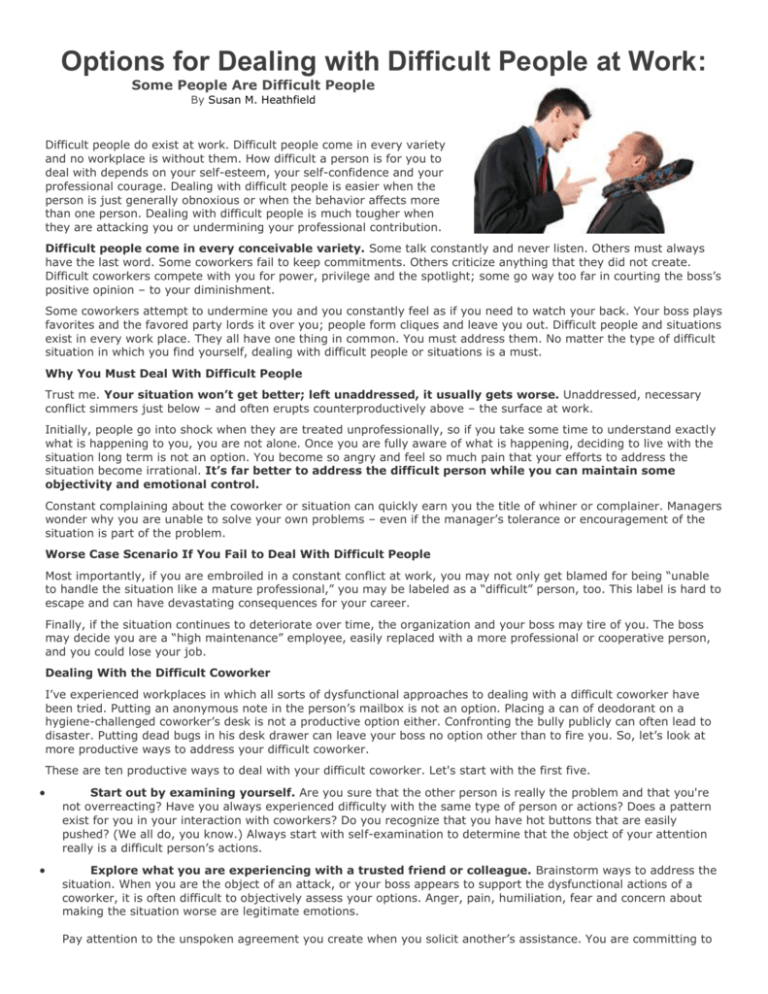
Options for Dealing with Difficult People at Work: Some People Are Difficult People By Susan M. Heathfield Difficult people do exist at work. Difficult people come in every variety and no workplace is without them. How difficult a person is for you to deal with depends on your self-esteem, your self-confidence and your professional courage. Dealing with difficult people is easier when the person is just generally obnoxious or when the behavior affects more than one person. Dealing with difficult people is much tougher when they are attacking you or undermining your professional contribution. Difficult people come in every conceivable variety. Some talk constantly and never listen. Others must always have the last word. Some coworkers fail to keep commitments. Others criticize anything that they did not create. Difficult coworkers compete with you for power, privilege and the spotlight; some go way too far in courting the boss’s positive opinion – to your diminishment. Some coworkers attempt to undermine you and you constantly feel as if you need to watch your back. Your boss plays favorites and the favored party lords it over you; people form cliques and leave you out. Difficult people and situations exist in every work place. They all have one thing in common. You must address them. No matter the type of difficult situation in which you find yourself, dealing with difficult people or situations is a must. Why You Must Deal With Difficult People Trust me. Your situation won’t get better; left unaddressed, it usually gets worse. Unaddressed, necessary conflict simmers just below – and often erupts counterproductively above – the surface at work. Initially, people go into shock when they are treated unprofessionally, so if you take some time to understand exactly what is happening to you, you are not alone. Once you are fully aware of what is happening, deciding to live with the situation long term is not an option. You become so angry and feel so much pain that your efforts to address the situation become irrational. It’s far better to address the difficult person while you can maintain some objectivity and emotional control. Constant complaining about the coworker or situation can quickly earn you the title of whiner or complainer. Managers wonder why you are unable to solve your own problems – even if the manager’s tolerance or encouragement of the situation is part of the problem. Worse Case Scenario If You Fail to Deal With Difficult People Most importantly, if you are embroiled in a constant conflict at work, you may not only get blamed for being “unable to handle the situation like a mature professional,” you may be labeled as a “difficult” person, too. This label is hard to escape and can have devastating consequences for your career. Finally, if the situation continues to deteriorate over time, the organization and your boss may tire of you. The boss may decide you are a “high maintenance” employee, easily replaced with a more professional or cooperative person, and you could lose your job. Dealing With the Difficult Coworker I’ve experienced workplaces in which all sorts of dysfunctional approaches to dealing with a difficult coworker have been tried. Putting an anonymous note in the person’s mailbox is not an option. Placing a can of deodorant on a hygiene-challenged coworker’s desk is not a productive option either. Confronting the bully publicly can often lead to disaster. Putting dead bugs in his desk drawer can leave your boss no option other than to fire you. So, let’s look at more productive ways to address your difficult coworker. These are ten productive ways to deal with your difficult coworker. Let's start with the first five. Start out by examining yourself. Are you sure that the other person is really the problem and that you're not overreacting? Have you always experienced difficulty with the same type of person or actions? Does a pattern exist for you in your interaction with coworkers? Do you recognize that you have hot buttons that are easily pushed? (We all do, you know.) Always start with self-examination to determine that the object of your attention really is a difficult person’s actions. Explore what you are experiencing with a trusted friend or colleague. Brainstorm ways to address the situation. When you are the object of an attack, or your boss appears to support the dysfunctional actions of a coworker, it is often difficult to objectively assess your options. Anger, pain, humiliation, fear and concern about making the situation worse are legitimate emotions. Pay attention to the unspoken agreement you create when you solicit another’s assistance. You are committing to act unless you agree actions will only hurt the situation. Otherwise, you risk becoming a whiner or complainer in the eyes of your colleague. Approach the person with whom you are having the problem for a private discussion. Talk to them about what you are experiencing in “I” messages. (Using “I” messages is a communication approach that focuses on your experience of the situation rather than on attacking or accusing the other person.) You can also explain to your coworker the impact of their actions on you. Be pleasant and agreeable as you talk with the other person. They may not be aware of the impact of their words or actions on you. They may be learning about their impact on you for the first time. Or, they may have to consider and confront a pattern in their own interaction with people. Worst case? They may know their impact on you and deny it or try to explain it away. Unfortunately, some difficult people just don’t care. During the discussion, attempt to reach agreement about positive and supportive actions going forward. Follow up after the initial discussion. Has the behavior changed? Gotten better? Or worse? Determine whether a follow-up discussion is needed. Determine whether a follow-up discussion will have any impact. Decide if you want to continue to confront the difficult person by yourself. Become a peacemaker. (Decide how badly you want to make peace with the other person and how much you want your current job. Determine whether you have experienced a pattern of support from your boss.) If you answer, “yes,” to these questions, hold another discussion. If not, escalate and move to the next idea. You can confront your difficult coworker’s behavior publicly. Deal with the person with gentle humor or slight sarcasm. Or, make an exaggerated physical gesture – no, not that one – such as a salute or place your hand over your heart to indicate a serious wounding. You can also tell the difficult person that you’d like them to consider important history in their decision making or similar words expressed positively, depending on the subject. Direct confrontation does work well for some people in some situations. I don’t think it works to ask the person to stop doing what they’re doing, publicly, but you can employ more positive confrontational tactics. Their success for you will depend on your ability to pull them off. Each of us is not spur-of-the-moment funny, but if you are, you can use the humor well with difficult coworkers. If you have done what you can do and employed the first five recommended approaches with little or no success, it’s time to involve others. Note that you are escalating the situation. Prepare to talk with your boss. Take notes and address the issues, not as interpersonal problems, but as issues affecting your productivity, the work and your progress on projects. Tell your boss exactly what the difficult person does. Make a plan to address the issues. Perhaps involve your coworker's boss. Recognize that a good boss is likely to bring your difficult coworker and his supervisor into a three or four-way discussion at this point. Expect to participate in follow-up over time. Rally the other employees who might have an issue with the difficult person, too - carefully. Sometimes, a group approach convinces the boss that the impact of the behavior is wider and deeper than she had originally determined. Be careful with this approach, however. Know what works with your boss. You want to solve your problem, not make it look as if you are rabble-rousing and ganging up on another employee. If these approaches fail to work, try to limit the difficult person's access to you. Protect the needs of your business, but avoid working with the person when possible. Leave voluntary committees, Choose projects he or she does not impact. Don’t hurt your own career or your business, but avoidance is an option. Transfer to a new job within your organization. Depending on the size of your company, you may never have to work with this difficult coworker again. Fleeing is definitely an option. If all else fails, you can quit your job. What, flee, you ask? But, I wasn't the employee with the problem. I was not the difficult coworker. All I tried to do was my job. You're right. But, what price, in terms of your happiness and success, are you willing to pay to stay? You need to decide whether the good in your current situation outweighs the bad or whether the bad outweighs the good. If the good wins, stop complaining and get back to work. Back track on these recommended steps and retry some of them when appropriate. If the bad wins, redirect your energy to leaving your current employment. You'll be glad you did. Check out the second part of this article to find out how to conduct a stealth job search and much more about job searching.
